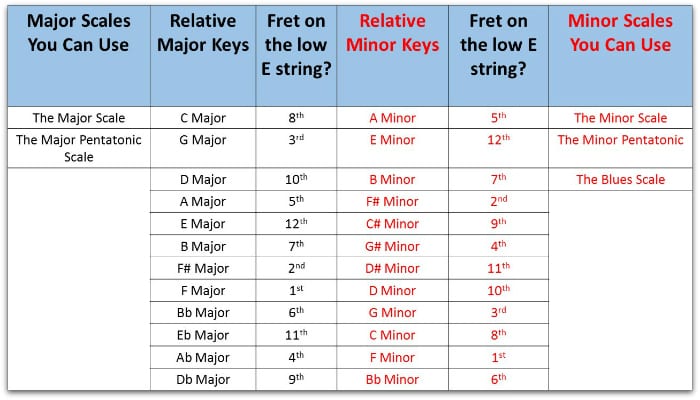The E Blues Scale
Here’s the guitar tab for the E blues scale:

- A 12 bar blues in the key of E.
- Anything in the key of E minor.
The E minor scale is the relative minor key of G major.
Therefore, you could use any of the E minor scales over:
- Anything in the key of G major.
Now, let’s look at our minor scales in the key of C# Minor.
Here are the guitar scales tabs for the minor scale, minor pentatonic and blues scale in the key of C# minor.
The C# Minor Scale
The C# Minor Pentatonic Scale
The C# Blues Scale

- C# minor chord progression.
- C# blues.
As C# minor is the relative minor key to E major. You could also use any of these scales over a chord progression in the key of E major.
Let’s take a look at our final minor key, the key of B minor.
Here are the guitar scales tabs for the minor scale, the minor pentatonic and the blues scale in the key of B minor.
The B Minor Scale
The B Minor Pentatonic Scale
The B Blues Scale
You could use these scales over:
- Anything in the key of B minor.
- A B blues
As D major is the relative major of B minor. You could also use these scales over anything in the key of D major.
What’s a relative minor scale?
A relative minor scale is a scale which shares the same notes as a major scale from the same key.
Both scales use identical musical notes. However they both have different starting points.
Let’s take a look at an example to understand this further.
For this example, we’re going to use the key of C.
The C major scale consists of the following notes.
C D E F G A B
The relative minor of C major, is A minor.
The A minor scale is made up of these notes.
A B C D E F G
Can you see how both scales use the EXACT same notes. However, the C major scale starts on the note C.
The A minor starts on the note A.
- Therefore, C major is the relative major key of A minor.
- A minor is the relative minor key of C major.
How do I find relative minor and major keys on the guitar?
Luckily, for us guitarists, there’s a really simple way of finding the relative major and minor keys on your guitar.
This works for ANY key.
This is a really useful tip, so listen up.
- For every major scale, you can find the relative minor scale, 3 frets down.
- For every minor scale, you can find the relative major scale, 3 frets up.
Try this:
- Play a C major scale which starts on the 8th fret of the low E string. (6th string.)
- Move down 3 frets to the 5th fret of the low E string. (6th string.)
- Play a minor scale starting on the 5th fret. (5th string.)
- You should be playing the A minor scale!
As mentioned before, both of these scales are EXACTLY the same. They just have different starting points.
You can also do this from a minor perspective. Let’s use the key of B minor for this example.
Try this:
- Play a B minor scale starting on the 7th fret of the low E string.
- Move up 3 frets to the 10th fret of the low E string.
- Now play a major scale shape, starting on the 10th fret.
- You should be playing the D major scale!
That’s it, that’s how you find the relative major and minor scales on the guitar.
Why is this useful for guitarists?
This is SO useful to know, as you now have two options when improvising.
- If something is in a major key. You can use the relative minor scale.
- If a piece of music is an a minor key, you could use the relative major scale.
One the hardest things about improvising is creating interesting sounds with a new scale.
However, if you understand relative minor and major keys, you can use ANY type of scale over ANY chord progression.
This comes in handy when you’re faced with playing in a uncomfortable key.
For example, if you find major keys hard but know how to use minor scales. You can use the relative minor scale over a major key.
- So, if you’re playing in the key of C major, you can use a A minor scale.
Or, if you find minor keys difficult, but find major scales easy. You can use the relative major scales over a minor key.
- So, if you were playing in the key of D major, you could use a B minor scale.
Here’s a list of ALL of the relative major and minor keys.
How do I play guitar scales in all keys?
To play guitar scales in all keys, you MUST change your starting note.
The great thing about guitar scales is that they are moveable patterns. Once you’ve learned one pattern, you’ve automatically learned 12 others too.
By changing your starting note, you’re changing what key the scale is in.
99% of all scales start on the low E string.
Here are ALL of the notes on the low E string:

For example, if you wanted to play a scale in the key of C. You would start it on the 8th fret of the low E string.
So each of your scales would become:
- The C Major Scale.
- The C Minor Scale.
- The C Minor Pentatonic.
- The C Blues Scale.
Let’s say you wanted to play a scale in the key of F#/Gb. You would start your scales on the 2nd fret of the low E string.
So each of your scales would become:
- The F# Major Scale.
- The F# Minor Scale.
- The F# Minor Pentatonic.
- The F# Blues Scale.
Here’s a really fun challenge that will take your guitar playing to the next level:
- Try playing the major scale in all 12 keys.
- Try playing the minor scale in all 12 keys.
- Try playing the minor pentatonic in all 12 keys.
- Try playing the blues scale in all 12 keys.
What Type of Guitarist Are You?
Take our 60-second quiz & get your results: Take The Quiz
Join the world's best online guitar school 🌎
- Get your own personalised guitar learning plan (customised just for YOU).
- World-class online guitar courses. Learn at your own pace.
- Community Campus & Learning Forum - A friendly community! Connect with our team & students. 😊
- Beginner Song library with chordsheets, tabs and tips. (Songs suitable for all levels!)
- Regular live streams, seminars and Q&A sessions - Learn from world-class guitar educators. Get all your questions answered!
Click here to learn more about National Guitar Academy membership 
Cool Guitar T-shirts 😎
Look cooler! Check out our merch: Click here to see our merch store
Want free guitar tips and video lessons delivered to your inbox?
Join over 250,000 other guitar learners and subscribe to our guitar-tips-by-email service. (It's free.)
We'll send you a series of lessons that will move you to the next level of your guitar journey.
Learn how everything fits together quickly, easily and effectively. We share ninja tips (for instant fun!) but also timeless fundamentals that will deepen your understanding.

Popular Lessons
How To Learn Guitar: An 11-Step Programme For Beginners
How To Choose The Perfect Beginner Guitar
More Cool Guitar Stuff
Learn about National Guitar Academy: About Us
Visit our YouTube channel for fun guitar videos.
Join us on Facebook for daily guitar tips.
Listen to our Learn Guitar Podcast for rapid guitar progress.
Check out our free chord lessons.
Get our best guitar tips & videos










